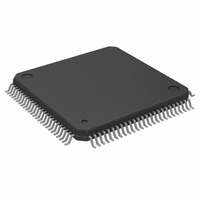SLXT914QC.B3 Intel, SLXT914QC.B3 Datasheet - Page 27

SLXT914QC.B3
Manufacturer Part Number
SLXT914QC.B3
Description
IC QUAD ETHERNET REPEATER 100QFP
Manufacturer
Intel
Type
Repeaterr
Datasheet
1.NLXT914PC.B3.pdf
(45 pages)
Specifications of SLXT914QC.B3
Rohs Status
RoHS non-compliant
Tx/rx Type
Ethernet
Voltage - Supply
4.75 V ~ 5.25 V
Current - Supply
180mA
Mounting Type
Surface Mount
Package / Case
100-QFP
Delay Time
-
Capacitance - Input
-
Other names
831521
Available stocks
Company
Part Number
Manufacturer
Quantity
Price
3.0
3.1
3.1.1
3.1.2
3.2
Datasheet
Application Information
Layout Requirements
The Twisted Pair Interface
The four, twisted-pair output circuits are identical. Each TPDOP/TPDON signal has a 24.9 Ω, 1%,
series resistor and a 120pF capacitor differentially across the positive and negative outputs. These
signals go directly to a 1:√2 transformer creating the necessary 100 Ω termination for the cable.
The TPDIP/TPDIN signals have a 100 Ω resistor across the positive and negative input signals to
terminate the 100 Ω signal received from the line. To calculate the impedance on the output line
interface, use:
The layout of the twisted-pair ports is critical in complex designs. Run the signals directly from the
device to the discrete termination components (located close to the transformers).
The signals running from the transformers to the connector should run in close pairs directly to the
connector. Be careful not to cross the transmit and receive pairs. One way to avoid a problem is to
run the receive pairs on the component side and the transmit pairs on the solder side. Careful
planning during the schematic and layout stages can avoid these problems.
The PCB layout should have no ground or power planes from the transformers to the connectors.
The data signals should be the only traces in this area. Place the chassis ground for the connectors
near the edge of the PCB, away from the signals, connecting the connector shield with the chassis.
The RBIAS Pin
The RBIAS signal sets the levels for the output drivers of the LXT914 Repeater. Any emissions or
common mode noise entering the device here could be measured on the twisted pair output signals.
The LXT914 Repeater requires a 12.4 kΩ, 1% resistor directly connected to RBIAS. This
connection should be as short as possible. The ground rails from the adjacent ground pins should
come directly off of the device to enclose the resistor and pin forming a shielded area between the
RBIAS connection and the switching signals on the PCB.
12-Port Hub Repeater
Figure 6
three LXT914 Repeaters. This application also provides two additional AUI ports—one DB-15
connector and one coaxial port. The application shown uses the asynchronous backplane mode so
no external backplane clock source is required.
Figure 6
the LXT914 Repeater devices at initialization. (This EEPROM could be replaced with a simple
pull down resistor on the SDI pin. This will select the default conditions of the set up register.) A
single 20 MHz crystal provides the SYSCLK for all three LXT914 Repeater. The
LXT914 Repeater hub repeater on Sheet 1 provides the AUI DB-15 connector as well as four
twisted-pair ports.
through
(Sheet 1) shows the XL93C46 EEPROM which downloads the setup parameters for all
Figure 9
Table 19
Intel
®
Order Number: 248989, Revision: 003
LXT914 Flexible Quad Ethernet Repeater
(Sheets 1 through 4) show a simple 12-port hub repeater application with
lists transformers suggested for use with the LXT914 Repeater.
(24.9 Ω + 24.9 Ω)
*
√2
Intel
2
≈ 100 Ω.
®
LXT914 Flexible Quad Ethernet Repeater
31-Oct-2005
27












